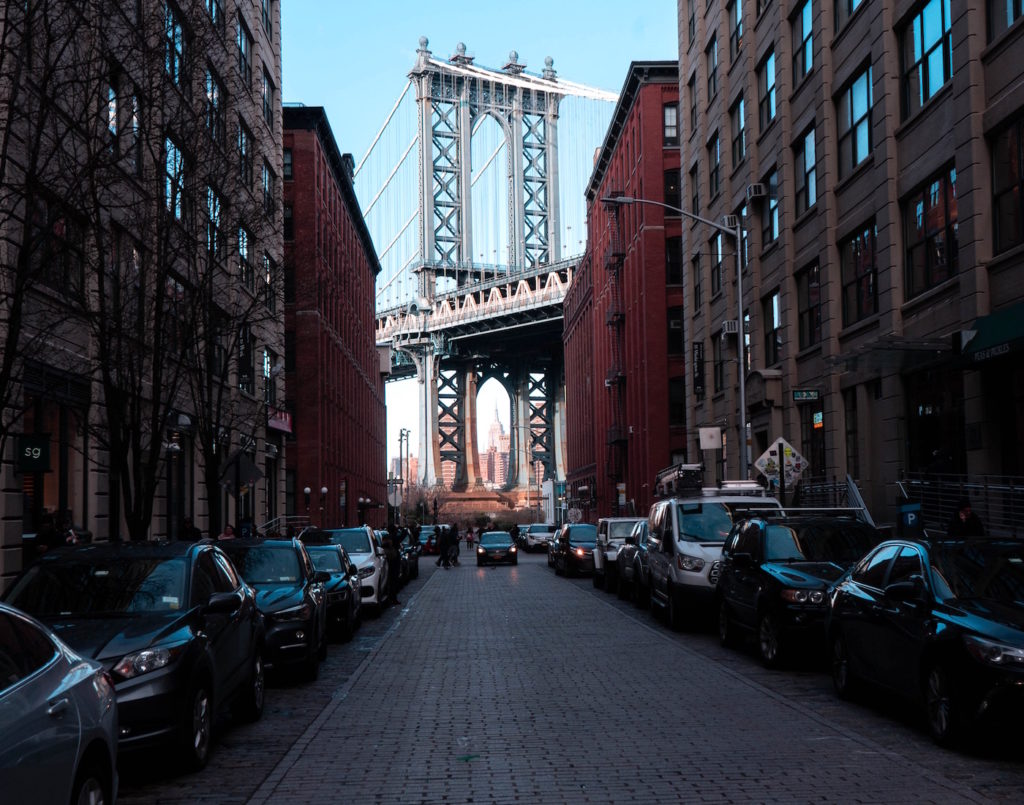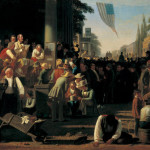In a world suffering from pernicious individualism, innovative and bold ideas are necessary if government is to help communities encourage, and be on their own conducive to, human flourishing.
In New York City, which has a population of nearly 8.4 million, personal and public space is limited. The city is also deficient in playgrounds and parks space. In fact, New York City Comptroller Scott Stringer, a progressive Democrat with mayoral ambitions, recently released a report chiding the city for its lack of playground space. Stringer’s report included an innovative plan that would entail reclaiming some streets currently used for vehicular traffic and parking by transforming them into public parks.
Stringer’s plan, named the “Pavement to Playgrounds” program, recommends that New York City identify residential streets with minimal vehicle traffic in neighborhoods currently lacking playground space. Playgrounds would be built in the middle of these blocks, and angled vehicle parking would be configured at either side of the blocks. The report says that the angled parking scheme would keep the number of parking spaces per block constant while also giving delivery trucks and service vehicles continued street access.
Stringer’s plan is laudable, and it brings innovative ideas into the conversation. New York City officials should move to institute the plan in some form. These newly reclaimed community spaces would be a welcome addition for New Yorkers. What is truly needed, however, is for New York City officials to do considerably more than even the plan’s suggestions.
Start your day with Public Discourse
Sign up and get our daily essays sent straight to your inbox.Streets Should Not Be Parking Lots
The discussion of parks and streets could raise an important question for those who may not ponder these urban questions regularly: Why, in the first place, are residential streets in a crowded city like New York monopolized by a few residents for the continuous, near-permanent, storage of their vehicles? This is not a question about whether payment should be required for parking. Rather, one must consider why whole blocks in densely populated cities are designed primarily for the movement and storage of vehicles.
Stringer’s plan, although a good first step, is overly generous to the current mentality that blocks by nature must be split into sidewalks for walkers and streets for vehicles. A new mentality must be formed. People are simply accustomed to the scenario that sidewalks are for walking and that streets are for vehicle flow and parking. A robust reclamation of property for public park space will necessitate looking at more than merely, as Stringer’s plan does, blocks “either disconnected from the local grid or at dead ends.” Healthy reclamation will also require more than mid-blocks to be reclaimed, namely the elimination as well of some parking spaces, something that Stringer’s plan sought to avoid.
Reclaiming the Streets
According to United States Census American Community Survey data from 2017, only about 45 percent of New York City households own a vehicle. It is unknown how many private parking spaces exist, but they surely house a significant number of parked vehicles. In other words, the large amount of space currently devoted to public parking is being used by a relatively small percentage of New Yorkers—those who can afford vehicles and their insurance and upkeep but do not have, or are choosing not to use, private parking.
One way to reclaim space that would be less disruptive, less costly, and easier to implement than Stringer’s methods would be to begin reclaiming one side of some blocks. On most blocks, vehicle traffic moves down the center of the street, and there is space for vehicle parking on either side. On blocks without curb cuts, which denote Department of Buildings certified access to private parking spaces, one side could be reclaimed for public space, thereby extending the sidewalks enough that trees and benches can be placed in the enlarged spaces.
Reclaiming just one side of the street reduces potential protests from special interests that would argue that claiming full blocks will put individuals at risk because of the reduction of vehicular access. This plan would leave half the amount of parking and keep vehicular traffic flowing as usual. This plan could also make considerable headway toward reframing mentalities, helping citizens begin to see nearly all parking areas on residential side streets as worthy of reclamation.
Reclaiming city streets from vehicle parking spaces does not curtail the right to own vehicles. Driveways, alleyways, personal garages, underground parking garages, and elevated parking garages, all of which are on private property, would not be affected. In fact, government can create favorable climates for businessmen who will come to see income-producing opportunities in the construction of private parking garages.
Blocks for People
Russell Kirk once asserted that “the community called a city must nurture roots, not hack through them.” When government policies are hindering the flourishing of communities, as in the case of the residential block parking, government has an even greater duty to act for the greater good.
Park spaces serve as community-building areas. As Jane Jacobs has written, “For communities to exist, people must encounter one another in person.” In a city starved for public park space and playgrounds, providing vast amounts of space for the parking of a minority of New Yorkers’ vehicles does little to create a sense of shared community space among residents. Reclaiming many of these free vehicle parking spaces for park use, however, would create opportunities for community building.
Further, these small parks, existing on blocks themselves, would be so localized that they would create a sense of ownership by block residents. As Aristotle argued, men care about what is their own. Rather than large parks that are shared by considerable numbers of people from a larger neighborhood or neighborhoods, these block-based parks would be shared by smaller numbers of people—by those who live on the block. When government creates shared space, it must make the people feel as those the space is theirs, for this is the only way that space will be cared for when it is held in common.
The Health Benefits of Urban Tree Parks
Recent data confirm the theory that communal spaces contribute to the well-being and flourishing of citizens. An analysis of research from the American Enterprise Institute Survey on Community and Society shows that Americans who live closer to community spaces like parks trust others more and are less lonely. As the study’s authors summarize: “Our findings suggest that living in communities rich in amenities positively affects social goods such as trust, sociability, and neighborliness, while decreasing social maladies such as loneliness.” In addition, those nearer to community amenities report more positive feelings about their communities and show a greater desire to remain there.
These communal spaces under a canopy of trees will greatly enhance the life of citizens, for urban trees have myriad mental and physical health benefits. A report by Local Governments for Sustainability shows that “[the urban forest] functions as a location for recreation and escape from the stresses of urban life.” Further, “[i]ncreased pedestrian traffic encourages neighborhood interactions and fosters the development of community identity.”
These data underscore the observations of Jane Jacobs, who found the lack of walkers in American and Canadian suburbs to be “a visible sign that much of North America has become bereft of communities.” She lamented how “One can drive today for miles through American suburbs and never glimpse a human being on foot in a public space, a human being outside a car or truck.” The concern is that if people are not walking, they are not talking.
Studies show that green spaces filled with trees also help to reduce noise pollution and have even been shown to reduce crime. In New York City, the Center for Urban Forest Research estimates that trees produce $5.60 in benefits for every $1.00 that is spent on tree care. Two Nature Conservancy reports conclude that the planting of trees in urban areas will help in cleaning pollution from the air and in reducing temperatures, and that the health benefits include decreased stress levels, increased mental focus, the promotion of physical activity, an increase in immune system functioning, and a decrease in inflammation. Further, one of the reports say that because trees need to be close to people and their homes in order to have the benefits of pollution removal and temperature mitigation, trees planted in designated parks set away from people and homes will prove far less a benefit than trees located closer to people and their homes. Thus, reclaiming vehicle parking space on blocks where people live will have the greatest health benefits.
These health benefits are considerable. A study in the American Journal of Preventive Medicine found that, in fifteen American states where trees were destroyed by an invasive beetle species, mortality increased as a result of higher respiratory illness and cardiovascular-related ailments. More broadly, a study released in 2019 estimated that the dangerous Particulate Matter 2.5 pollution killed an astounding 107,000 Americans in 2011. Another study estimates that worldwide, 3.3 million people die yearly from outdoor air pollution, with that number likely to double by 2050. Yet another study concludes: “As city populations grow, urban trees cannot be viewed as a luxury: Trees are an essential component of a livable community and a core strategy for improving public health.”
A USDA Forest Service study estimates that trees remove over 1,567,486,684 pounds of air pollution annually from American cities in the lower forty-eight states. Consider also that these estimates take into account earlier research that found that the average city tree canopy covers only 27 percent of cities. The study further reports that automobiles can have an inverse effect on the natural filtering work performed by trees.
Automobiles, then, not only monopolize vast amounts of public space on residential city streets in their idle repose, but they have a detrimental effect on residents’ health. According to Environmental Protection Agency data, New York City’s five boroughs currently average elevated levels of ozone pollution and the Borough of Manhattan measures elevated levels of the dangerous Particulate Matter 10 pollution.
New York City streets need trees, not vehicle parking spaces. The reclamation of city streets for communal spaces filled with trees results in numerous positive effects, from community-building to improving mental and physical health.
A Bipartisan Effort
Throughout the country, the expansion of public parks and walkable streets is something on which many on both the left and right can work together. In the midst of deep social divisions and vituperation, those of different ideals must work together when they can find common ground.
Scott Stringer, for instance, is an unabashed social progressive. Social conservatives might not vote for politicians like Stringer, but when they can work together in good conscience, they must do so for the sake of the common good. Reclaiming residential city streets and installing communal park space filled with tree canopies is one way that people with different ideals can work together in order to encourage human flourishing.














